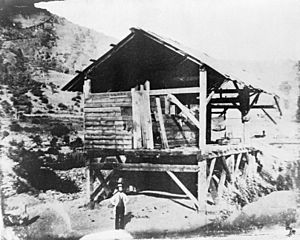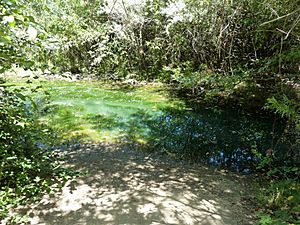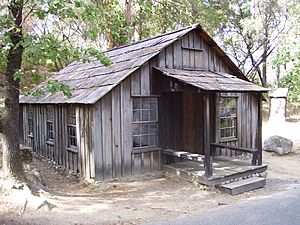James W. Marshall facts for kids
Quick facts for kids
James W. Marshall
|
|
|---|---|

James Marshall, around 1884
|
|
| Born |
James Wilson Marshall
October 8, 1810 Hopewell Township, New Jersey, U.S.
|
| Died | August 10, 1885 (aged 74) Kelsey, California, U.S.
|
| Signature | |
James Wilson Marshall (born October 8, 1810 – died August 10, 1885) was an American carpenter and sawmill operator. On January 24, 1848, he found gold at Coloma, California. This small town is on the American River, about 36 miles northeast of Sacramento. His discovery started the famous California Gold Rush.
The sawmill belonged to Johann (John) Sutter, who hired Marshall to build it. But when gold was found, everyone focused on finding gold instead of the mill. The mill eventually broke down and was never used as planned. Sadly, neither Marshall nor Sutter became rich from the gold discovery.
Contents
Early Life and Journey West
James Wilson Marshall was born on October 8, 1810. His family lived in Hopewell Township, New Jersey. He was the oldest of four children and the only boy. In 1816, his family moved to Lambertville.
In 1834, James left New Jersey and traveled west. He spent time in Indiana and Illinois. By 1844, he settled in Missouri and started farming near the Missouri River. There, he got sick with malaria. His doctor told him to leave Missouri to get better.
James joined a group traveling west and arrived in Oregon in the spring of 1845. He then headed south into California. In mid-July, he reached Sutter's Fort. This was a farming settlement founded by John Sutter. California was still part of Mexico at that time.
Sutter hired Marshall to help with carpentry work at the fort and sawmill. He also helped Marshall buy land and gave him cattle. Marshall started farming again.
Building Sutter's Mill
The Mexican–American War began in May 1846. Marshall joined the California Battalion and fought in the Bear Flag Revolt. When he returned to his ranch in early 1847, all his cattle were gone. Without his way to make money, Marshall lost his land.
Marshall then partnered with Sutter to build a sawmill. Marshall was in charge of building and running the mill. In return, he would get a share of the lumber. He looked for a good spot and chose Coloma, California. This place was about 40 miles (64 km) upstream from Sutter's Fort on the American River.
Construction began in late August. Marshall's crew included local Native Americans and soldiers from the Mormon Battalion. They were on their way to Salt Lake City, Utah.
Work continued into January 1848. They found that the ditch that carried water away from the waterwheel was too small. Marshall decided to use the river's force to dig and make the ditch bigger. This could only be done at night to keep the workers safe during the day. Each morning, Marshall checked the ditch.
The Gold Discovery
On the morning of January 24, 1848, Marshall was checking the channel below the mill. He saw some shiny flecks in the riverbed.
Marshall's crew tested the metal. They boiled it in lye soap and hammered it to see if it would flatten easily. The tests confirmed it was gold. Marshall was still focused on finishing the sawmill, but he let his crew look for gold in their free time.
Four days later, Marshall returned to Sutter's Fort. The war had ended, and California was about to become part of America. Marshall told Sutter about his discovery. Sutter tested the gold and said it was "of the finest quality, of at least 23 karat [96% pure]".
After the Discovery
News of the gold discovery quickly spread around the world. For Marshall, the immediate effects were not good. His sawmill failed because all the men left to search for gold. Soon, many gold seekers arrived and forced him off his land. Marshall then left the area.
Marshall came back to Coloma in 1857. In the 1860s, he had some success with a vineyard (a place where grapes are grown). But this business failed later in the decade. This was mainly because of higher taxes and more competition. He tried looking for gold again, hoping to find success.
He became a partner in a gold mine near Kelsey, California. However, the mine produced no gold, and Marshall was left with almost no money. In 1872, the California State Legislature gave him money for two years. This was to honor his important role in California's history. The money was renewed in 1874 and 1876 but stopped in 1878. Marshall, with no money, ended up living in a small cabin.
Marshall's Later Life and Legacy
James Marshall died in Kelsey on August 10, 1885. In 1886, a group called the Native Sons of the Golden West felt that the "Discoverer of Gold" deserved a monument. In May 1890, five years after Marshall's death, this group successfully asked the State Legislature for money. They received $9,000 to build a monument and tomb. This was the first monument of its kind in California.
A statue of Marshall stands on top of the monument. It points to the exact spot where he found gold in 1848. On October 8, 2010, the monument was rededicated. This was done to celebrate the 200th anniversary of James W. Marshall's birth.
See also
 In Spanish: James W. Marshall para niños
In Spanish: James W. Marshall para niños




